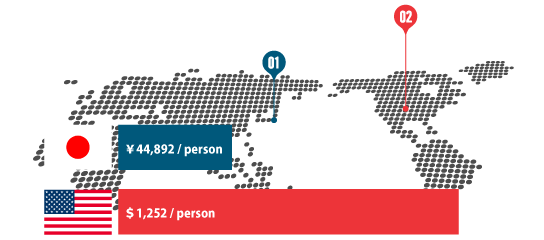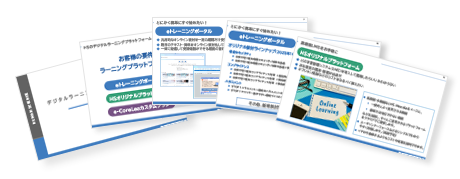2017.09.27
Basic e-Learning for Corporate Education Part 1 (Introduction)
"Introduction to e-Learning in Corporate Education" series will introduce the basics of e-learning in corporate education. We will start from the basics to explain what e-learning is in corporate education. Although many of you may already know, we hope you will read this with a beginner's mind.
This time, as part 1, we will share the information that will serve as the basis for the following articles.
First of all, let's take a look at the current state of corporate education in Japan.
The cost of education and training in Japan is 44,892 yen per employee*1 (including e-learning and group training). In contrast, in the United States it is 1,252 dollars (about 150,000 yen)*2. Although there may be some margin of error due to exchange rates, this is a cost difference of more than three times.
Employee education (and the resulting improvement in service and quality) is essential for the development of a company. This level of investment could potentially have an impact on the future of Japanese companies.
It is not easy to raise the level of education and training expenses for companies to the level of the United States, and it may not even be necessary given the differences in social structure and assumptions. However, the quality of education can surely be improved. Therefore, we would like to take a step back and reevaluate from the basics.

*1 Institute for Labor and Management Research "2016 Survey on the Actual Expenses for Education and Training (40th Edition)"
*2 ATD "Investment in Learning Increases for Fourth Straight Year" (2015 survey, calculated at 1 dollar = 120 yen). This survey includes salaries of employees responsible for talent development, which differs from the Japanese survey.
What is e-learning?
There are various types of e-learning.
Generally, it refers to learning using a learning management system (LMS) in the industry, but broadly speaking, it includes various types of learning using digital devices such as PCs. This includes publishing on websites, distributing PDFs via email, distributing on CD/DVD, and even individual learning using Wikipedia or mobile apps.
The content covers a wide range, but generally it is classified into three categories: knowledge, skills, and attitudes.
| Compliance, information security, etc. | |
| Technical skills in machinery operation, software operation, customer service, etc. | |
| Business etiquette, diversity, environmental education, etc. (things that appeal to consciousness, heart, and impression) |
It is necessary to carefully plan the expression method and provision method for each classification.
※ In the past, "skills" were limited to acquiring knowledge for action (+ promoting action), but with the development of the latest technologies such as VR/AR/MR, it is becoming possible to acquire "practical skills" through simulated experiences.
In addition, you can classify from various vectors.
・Target audience (young people, everyone, limited to specific regions, etc.)
・Content type (video, game, quiz, presence of audio, etc.)
・Purpose of implementation (evaluation, skill acquisition, compliance with rules and regulations, etc.)
・Type of learner (company employees, BtoB employees, individuals)
Planning is the first step in creating e-learning materials, as it involves planning the structure, expression, and technology used based on differences in features and objectives. If there is a discrepancy in the planning, it can lead to misunderstandings between the learners and the final content, resulting in comments such as "I don't want to receive this kind of education" or "It's hard to understand."
School Education and Corporate Education
When we talk about "education", it is often associated with school education, but corporate education is adult education and has a significant aspect of human resource development, with significantly different goals and target audience from school education.
| School Education | Corporate Education | |
|---|---|---|
| Target Audience Characteristics | Young and honest | People of all ages and genders have varying levels of motivation. |
| Purpose | Student's personal goals (such as entering xx school), establishment of basic academic skills, mastery of general education and expertise, vocational training | Company's goals achieved, or individual goals achieved (company growth, incentive acquisition, evaluation and technical improvement) |
In order to improve the quality of adult education,
not only a mechanism for remembering, but also mechanisms for eliciting motivation and implementing practical skills are necessary. Because e-learning is a one-way communication that is not face-to-face or interactive, it is necessary to incorporate these measures firmly. In addition, employees are not working for the purpose of "learning". It is necessary to motivate not only those who feel a sense of crisis that they must "learn" in order to work, but also those who are motivated.
As a basic theory for this, "Instructional Design" (ID) is being utilized.
The second session will focus on instructional design, which is a theory of educational design.

Author:
Keigo Ryuno
Education Solutions Department, Consulting Unit
・Experience as a training instructor and web designer
・Engaged in education design and e-learning development
・Learning Designer (eLC certified)
・ATD International Professional Member
Contact Us:
Business Development Department Morio
Phone Number: 03-5321-3111
hsweb_inquiry@science.co.jp
Icons made by Vectors Market from www.flaticon.com is licensed by CC 3.0 BY
Illustrated by http://all-free-download.com/
Latest Blog
- 2024.04.02
- English Learning Using Moodle and ChatGPT












